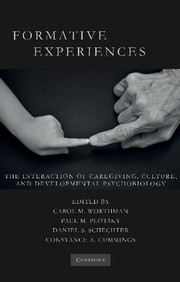Book contents
- Frontmatter
- Contents
- List of Figures
- List of Tables
- List of Contributors
- Foreword by Robert Sapolsky
- Preface
- List of Abbreviations
- Introduction
- SECTION ONE HISTORICAL, CROSS-CULTURAL, AND DEVELOPMENTAL SCIENCE PERSPECTIVES
- SECTION TWO HOW EXPERIENCE INTERACTS WITH BIOLOGICAL DEVELOPMENT
- SECTION THREE FORMATIVE RELATIONSHIPS WITHIN AND ACROSS GENERATIONS
- SECTION FOUR SOCIAL AND CULTURAL CONTEXTS OF CHILDHOOD DEVELOPMENT – NORMATIVE SETTINGS, PRACTICES, AND CONSEQUENCES
- SECTION FIVE FEAR, FUN, AND THE BOUNDARIES OF SOCIAL EXPERIENCE
- SECTION SIX PUBLIC HEALTH, EDUCATION, AND POLICY IMPLICATIONS
- 19 Translations from Human Development to Public Policy
- 20 Global Perspectives on the Well-Being of Children
- 21 Response to: Global Perspectives on the Well-Being of Children
- Index
- References
20 - Global Perspectives on the Well-Being of Children
Published online by Cambridge University Press: 26 May 2010
- Frontmatter
- Contents
- List of Figures
- List of Tables
- List of Contributors
- Foreword by Robert Sapolsky
- Preface
- List of Abbreviations
- Introduction
- SECTION ONE HISTORICAL, CROSS-CULTURAL, AND DEVELOPMENTAL SCIENCE PERSPECTIVES
- SECTION TWO HOW EXPERIENCE INTERACTS WITH BIOLOGICAL DEVELOPMENT
- SECTION THREE FORMATIVE RELATIONSHIPS WITHIN AND ACROSS GENERATIONS
- SECTION FOUR SOCIAL AND CULTURAL CONTEXTS OF CHILDHOOD DEVELOPMENT – NORMATIVE SETTINGS, PRACTICES, AND CONSEQUENCES
- SECTION FIVE FEAR, FUN, AND THE BOUNDARIES OF SOCIAL EXPERIENCE
- SECTION SIX PUBLIC HEALTH, EDUCATION, AND POLICY IMPLICATIONS
- 19 Translations from Human Development to Public Policy
- 20 Global Perspectives on the Well-Being of Children
- 21 Response to: Global Perspectives on the Well-Being of Children
- Index
- References
Summary
The conditions under which children grow and develop vary widely according to the combined influences of history, geography, culture, politics, and economics, and also to the unique features of each individual life. The dominant scholarship of the West tends to focus on the childhoods and the circumstances of a minority of children in the world. However, the lot of the greatest number of young children is characterized by tenuous survival, hunger, poor growth, and minimal schooling. Worsening global inequality, disasters, and health threats on the scale of the HIV epidemic add further stress to the formative experiences of young children. Poor children live in what is increasingly a shadow world – a trailing, friable image of the world that children on the better side of the tracks inhabit.
Recent analyses of longitudinal data from developing countries reveal the long-term, intergenerational impact of poverty and under-nutrition on human potential, as expressed in growth, education, and earnings. Yet despite the strong influence of material circumstances in early life, research on resilience across a variety of cultures indicates the presence of three potentially powerful counter forces: warm responsive caregiving in the early years, meaningful family and social relations, and opportunities to learn and succeed. This chapter discusses the well-being of children globally, threats to children's health and development and pathways through which these threats act adversely and, lastly, potential large-scale interventions that protect children and enhance their capabilities.
- Type
- Chapter
- Information
- Formative ExperiencesThe Interaction of Caregiving, Culture, and Developmental Psychobiology, pp. 531 - 548Publisher: Cambridge University PressPrint publication year: 2010
References
- 1
- Cited by



